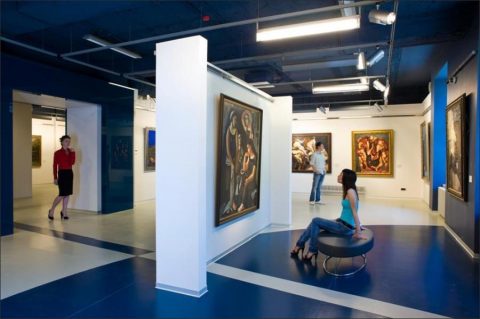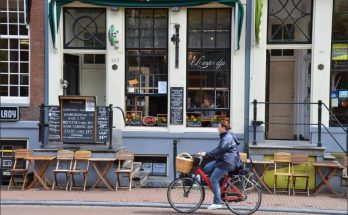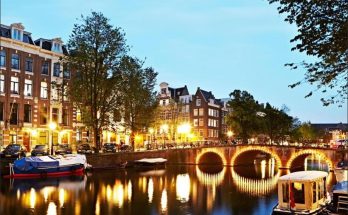Dutch art is not exclusively the property of the Dutch people; its value is not confined within the narrow limit of their own small land. Dutch art belongs to the whole of mankind.
The Anglo-Saxon peoples have always shown a great interest in the achievements of Dutch painters: as early as the seventeenth century many Dutch artists travelled to England and there were many painters, then and later, who found their principal market in that country, so that a considerable portion of their work can still be found there, more valuable sometimes than that which their fatherland retained. The United States, too, has many family connections with the old seafaring and trading Holland, and from the beginning has possessed artistic links with the Low Countries. In more recent times the U.S.A. has shown continued appreciation of the creations of Dutch art.
Many valuable works of art are to be found in American museums and private collections and reflect in the New World all that Dutch art has represented to bygone centuries and still continues to represent to later generations. Yet, especially outside the Netherlands, Dutch art of before and after the seventeenth century is all too often dismissed as being of little significance: people hereby ignore the fact that a period of great artistic achievement does not emerge suddenly and unprepared, nor does it vanish again after a short time of unprecedented glory. In reality the glorious school of the seventeenth-century realists is but one aspect of a continuous chain of great periods of art, a dazzling aspect which by its brilliance blinds the eye to some extent to the other links of this chain.
Moreover, even seventeenth-century art cannot be fully understood and appreciated if the other aspects of this development remain unknown. It is, therefore, the aim of this book to give a survey of Dutch art in its entirety, from the very earliest, primitive beginnings up to the present day. It will deal not only with painting but also with the various aspects of architecture, with sculpture, and with the other branches of applied art. Nor will the cultural and historical backgrounds of this development be forgotten, for art cannot be dissociated from life. The aim of this book is thus to give a general survey of every aspect of Dutch life and art.
Such a survey, however, can only be fragmentary and, like all historical observations, the result of the personal choice and subjective opinion of the writer. In selecting the reproductions the author has, in so far as possible, avoided too well-worn paths. The widely known works of Dutch artists which can be found in every other book on this subject have, where possible, been omitted. By including lesser known works the author has sought to prove that Dutch art does not owe its reputation solely and exclusively to a few world-famous masterpieces. In addition, he has tried wherever possible to give a glimpse of the people of the various periods in their ordinary occupations, appearance and costume, thus imparting reality to the distinctive atmosphere and distinctive colour of the time in which they lived. Man is the great actor upon the stage of history. In learning to know him we learn to know and understand his work and art.
Fortune has favoured the Dutch people, for their country occupies a key position in the northwestern corner of Europe, geographically, economically, and sometimes even politically. For centuries it dominated the vital trade routes; it was always there, where these routes met or crossed, that the focal points of prosperity and culture came to lie. In the beginning it was in the Maas valley, where land and water routes met, that merchants and travellers from all parts came together, and from whence they departed to the four corners of the earth. Later the towns of Brabant and Flanders, even more than those of Maas valley, directed their energies to countries overseas; from the Zwin and the Scheldt the crossing to England was short and, following their own coasts, the Dutch could sail all the seas of the ancient world.
Finally, when the Zwin silted up and the Scheldt was cut off, the men of Holland and Zeeland dominated the trade and navigation routes. Their spirit of enterprise was not confined to the coasts of Europe: as born seafarers they focused their desires upon the lands beyond, far across the seas in a newly discovered world. They travelled to the immense land on the other side of the ocean, they sailed round the Cape to India, to China, and to Japan. There they traded with the riches which everywhere fell to their share. Others of their compatriots settled in these distant regions and named them New Holland and New Zealand. They laid the foundations of an empire, and secured for their native country centuries of luxury and prosperity.
Economic prosperity is not necessarily accompanied by a high standard of culture, but in the Netherlands this was always so. Time and again material wealth was attended by exceptional artistic skill and the genius of the artists was only equalled by the liberality of their patrons. In the three periods of prosperity mentioned we see a gradual transference of patronage.
During the Romanesque period, the heyday of the Maas valley culture, most commissions came from the church; in the period of the Flemish-Brabant Gothic the nobles and cities also encouraged the arts. The Golden Age in Holland, an age which extended beyond the seventeenth century, is essentially a culture of the middle class. In our day, the patronage of the arts has once more passed into other hands. Middle class and princely patronage no longer exist. The new–whether true or false–religion of the Moloch which is called the state, would appear to have assumed the rights of church, principate, and merchant. Whether it will be worthy of its predecessors, only time will tell.
For the moment it remains a disturbing question. At the same time the avalanche of the ever increasing power, strength, and technical advance in the field of science has confused many values, distorted many truths, and undermined many apparent certainties. Will these techniques escape the control of modern man and lead him to destruction? This question is perhaps even more alarming than the first. The Christian will find consolation in the idea of Providence which, even here, has the final and decisive word, and as a Christian he is conscious that his goal lies elsewhere, that all else is but a means to an end. Whatever the answers, for the man of today a spiritual preoccupation with the achievements of the past is more than a relaxation; it is a necessity. In this too the present volume attempts to be of service to him.
To review and resume modern culture in life and art in the same manner as that of earlier periods is not possible for the contemporary critic. All is still in full dynamic development, the image of the times is still being determined by search and experiment, and the distance necessary for the formulation of a responsible opinion is lacking. The opinion of posterity nearly always differs from that of the contemporary who considers himself an eye-witness of events.
If in this book we none-the-less devote some pages and a number of plates to the later twentieth century, we do it solely to mark the present epoch and, with the help of a certain amount of material, to prepare the way for a perspective of the future. We refrain from any classification, being convinced that to venture any definitive judgment would be to lay ourselves open to the certainty of later contradiction. The image of our period is an unfinished torso: time alone will complete it.



